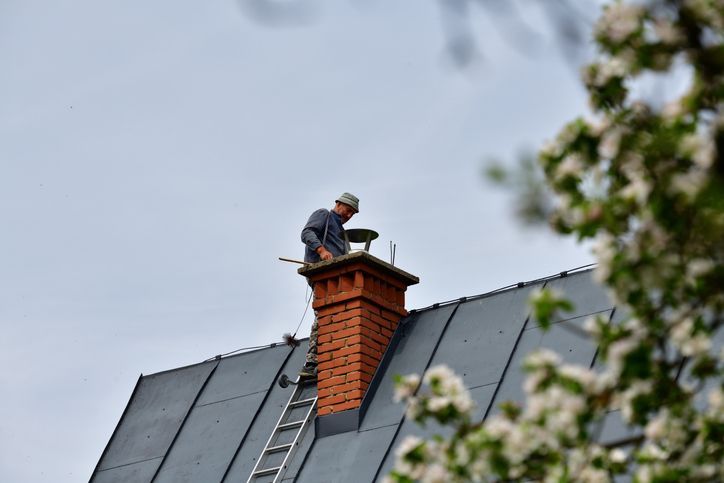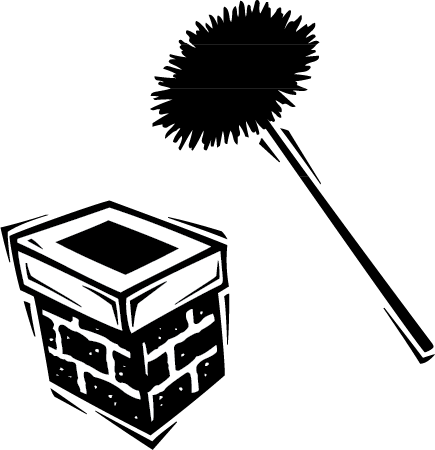Spring Chimney Cleaning: Why Older Homes Need a Post-Winter Checkup

Welcome Spring: A Crucial Season for Chimney Care
As Pittsburgh's long winter fades and the South Hills thaw out, homeowners begin shifting their focus to spring cleaning and home maintenance. But while it's easy to prioritize gardens, windows, and gutters, one of the most critical areas to address—especially in older homes—is your chimney.
Historic masonry chimneys are not only charming but also structurally complex and more susceptible to post-winter damage than newer models. Freezing temperatures, heavy snow, and prolonged fireplace use damage aging materials, potentially compromising safety and performance, making spring the best time for a thorough chimney inspection and professional cleaning.
This guide explains the unique vulnerabilities of older chimneys, outlines what happens during a post-winter checkup, and details how proper maintenance can help you protect your home, preserve its historical value, and avoid costly repairs.
How Winter Damages Older Chimneys
Older chimneys—especially those built with porous brick and aging mortar—are highly vulnerable to Pittsburgh's freeze-thaw cycles. Here's what winter leaves behind:
Freeze-Thaw Cycle: Silent but Destructive
Moisture seeps into brickwork and mortar during the winter. When temperatures drop below freezing, the water expands and contracts, causing cracks and weakening the structural integrity of your chimney over time. For homes built decades ago, the original mortar may already be brittle, compounding the risk. These microfractures may not be visible from the ground but can lead to more significant issues if neglected.
The damage caused by freeze-thaw cycles will accumulate. Each winter adds new stress, eventually leading to spalling, where the face of the brick flakes off. Once this starts, water penetration increases dramatically, accelerating the deterioration of the chimney structure. Older chimneys, particularly those without protective caps or liners, are significantly more prone to these problems.
Moisture Absorption and Long-Term Deterioration
Many historic chimneys lack modern water-resistant coatings, which means bricks can absorb significant amounts of moisture. Over time, this leads to a chain reaction of problems—from flaking bricks and crumbling mortar to rusted chimney components and interior wall staining. Once moisture infiltrates the structure, it can reach your attic, insulation, and ceilings, causing mold, rot, and even compromising indoor air quality.
Water damage also poses a serious risk to the chimney flue, which must remain intact to channel smoke and gases out of your home safely. When the flue liner is cracked or broken, dangerous gases like carbon monoxide can seep back inside. In older homes, where flue liners might already be made of fragile materials or not exist at all, the risks multiply.
Unseen Damage Builds Up
The signs aren't always obvious. Small cracks, missing mortar joints, or a crumbling chimney crown may go unnoticed until they lead to more serious issues like water leaks, smoke backup, or a chimney fire. Older homes are more likely to have chimneys with outdated designs, such as single-walled liners or no liner at all, making damage detection even more difficult without a professional inspection.
Pittsburgh's weather is particularly hard on masonry, and the South Hills region often experiences prolonged periods of freezing temperatures followed by sudden thaws. These fluctuations repeatedly stress chimney materials, making annual spring inspections a necessity rather than a luxury, especially for those living in homes built before the 1950s.
The Role of a Professional Chimney Inspection
A trained, certified chimney professional brings specialized knowledge and tools to the job, especially important for older homes where deterioration can hide in hard-to-spot areas. When it comes to chimney care, early detection is the best defense against significant repairs, fire hazards, and safety issues. Annual inspections not only safeguard your home but also extend the life of your chimney and fireplace system.
Professional chimney sweeps are trained to identify not only surface-level issues but also hidden threats that can worsen over time. These experts are certified by organizations like the Chimney Safety Institute of America (CSIA) and use advanced diagnostic tools to ensure nothing is missed during the inspection process. This level of scrutiny is significant for older homes, where small structural issues can be early signs of severe deterioration.
What's Included in a Post-Winter Inspection
Professional inspections are thorough and detailed. They usually include visual and video assessments of:
- Exterior masonry and mortar joints – Checking for cracks, gaps, and signs of spalling or moisture infiltration.
- Chimney cap and crown – Ensuring the crown is free of cracks and the cap is securely installed to keep out moisture and animals.
- Flashing around the roofline: Inspect for rust, gaps, or improper sealing that can lead to roof leaks.
- Flue lining condition: Assess for cracks, flaking, or shifting in clay tile or metal liners, particularly in older systems.
- Firebox and damper integrity: Ensuring that components open and close properly and aren't warped, rusted, or damaged.
- Signs of creosote buildup or obstruction – Identifying blockages, bird nests, or flammable buildup that could lead to chimney fires.
In some cases, professionals use specialized high-definition cameras to assess the entire length of the flue. This internal video scan can reveal hairline cracks, gaps in mortar joints, or evidence of previous fire damage—problems that are impossible to detect from outside the chimney. This is particularly important in older homes where flues may have gone decades without a thorough internal inspection.
What Professionals Look For
During a spring inspection, chimney technicians specifically look for signs of:
- Cracked or crumbling mortar joints
- Loose or spalling bricks
- Deteriorated or missing crown materials
- Rusted or disconnected flashing
- Flue liner damage, including cracks, gaps, and improper material use
They also inspect for blockages such as bird nests, leaves, fallen masonry, or creosote buildup that can affect ventilation and pose fire risks. Chimney pros will evaluate whether components like dampers, smoke chambers, and spark arrestors are functioning correctly and aligned with the home's heating system.
For older chimneys, they may also recommend modern upgrades like stainless steel liners or top-sealing dampers to improve performance and bring the system up to code.
Technicians also check whether the chimney is appropriately sized for the appliance it serves—a common issue in historic homes where conversions from coal to wood or gas were made without adjusting flue size. Incompatibility can lead to back-drafting, creosote buildup, and poor combustion efficiency.
By documenting each issue in a written report—often with photos or video—professionals help homeowners understand the condition of their chimneys and prioritize any necessary repairs or improvements. This transparency helps build trust while giving homeowners the tools they need to make informed decisions about their property's safety and preservation.
Why Older Homes Need More Frequent Inspections
Historic homes often have chimneys that predate modern building codes. That means they may lack crucial safety components or contain materials that are no longer deemed safe or effective. For instance, clay tile liners in older chimneys can crack and shift over time, especially under extreme temperature changes. These liners were once standard but are now known to be brittle and susceptible to breakage, especially in homes that regularly burn wood or experience dramatic seasonal changes.
Additionally, older chimneys may not have essential modern upgrades such as stainless steel flue liners, chimney caps to keep out animals and moisture, or properly installed flashing to prevent leaks. Many historic homes also have chimneys that were designed for coal-burning or oil-burning appliances rather than today's wood stoves or gas inserts. As a result, there can be incompatibilities between the chimney and the heating appliance, increasing the risk of poor draft, carbon monoxide buildup, and inefficient combustion.
These homes are also more likely to have experienced multiple winters without proper maintenance. In some cases, homeowners may not realize how long it's been since the last inspection or cleaning. Deterioration can accumulate gradually, and without professional oversight, minor problems can become serious hazards. Efflorescence (white staining from salt deposits), cracked crowns, and deteriorated mortar joints may be early warning signs that are easy to miss.
Scheduling annual or even biannual inspections ensures that problems are identified before they threaten your family's safety or your home's structural integrity. Regular inspections also provide peace of mind, especially when using the fireplace for supplemental heat in winter or hosting guests during the holidays. Spring, in particular, allows enough time to address issues before the fall rush and the start of the next heating season. It also provides ideal weather conditions for mortar repair, crown sealing, and exterior masonry work, which may not be possible once temperatures drop.
The Benefits of Spring Chimney Cleaning
After months of heavy fireplace use, spring chimney cleaning is one of the most critical services you can schedule, especially for older chimneys with decades of soot and creosote accumulation. This process not only safeguards your home but also helps your heating system operate more reliably and efficiently. By removing buildup and checking for obstructions, a spring cleaning ensures your chimney is in optimal condition long before it's needed again.
Remove Dangerous Creosote
Creosote is a highly flammable byproduct produced by wood-burning fires. It builds up in the flue and can ignite if not removed regularly. In older chimneys, where ventilation may already be compromised due to cracked liners, deteriorating masonry, or narrow flues, the risk is even greater. A spring cleaning eliminates this hazard right after the cold season, reducing the chance of a chimney fire next fall.
Creosote buildup occurs in stages:
- Stage 1: Flaky and easy to remove. Usually found in well-maintained chimneys.
- Stage 2: Tar-like and sticky. Requires more effort and specialized brushes.
- Stage 3: Glazed and hardened, it is extremely difficult to remove and highly combustible, and it may require chemical treatment or partial flue replacement.
If your chimney hasn't been cleaned in a while, you could be dealing with more advanced stages of buildup, which only a professional sweep can safely address using the right tools and techniques. Letting this buildup linger into warmer months only increases the risk of fire hazards down the line.
Prevent Blockages and Smoke Backup
Blockages are another primary concern. During the winter, animals like birds, squirrels, or raccoons may enter the flue seeking warmth. Debris, such as twigs, leaves, and even broken pieces of brick or tile, can accumulate inside the chimney, especially in older systems without protective caps.
These obstructions restrict airflow, reducing draft efficiency and potentially forcing smoke, ash, or carbon monoxide back into your living space. This is particularly dangerous in older homes, where chimney height, design, or construction may not conform to current safety standards. A professional cleaning clears these obstructions, restoring safe and effective operation while preventing noxious odors from building up in the off-season.
Improve Performance and Longevity
A clean chimney draws better, making your fireplace or wood stove more efficient and easier to use. It improves the combustion process, resulting in cleaner burns, fewer emissions, and better heat output. Regular cleanings also extend the lifespan of internal components like dampers, smoke shelves, and flue liners by reducing exposure to corrosive creosote, soot, and acidic condensation.
Routine spring cleanings can also help identify early signs of structural issues, such as flue liner cracks or shifting masonry, before they require major repairs. This preventative approach can save you thousands in repair or rebuild costs, especially for historic or custom-built chimneys.
Spring chimney cleaning is more than a good idea in the South Hills and other Pittsburgh neighborhoods with older housing—it's a vital part of responsible homeownership. Not only does it keep your home safer and more comfortable, but it also ensures that your chimney remains a reliable, efficient feature for years to come.

Author: Piccadilly Chimney Sweep
Since 1990, Piccadilly Chimney Sweep of Pittsburgh has provided Western Pennsylvania with top-quality chimney cleaning, repairs, and rebuilding, as well as fireplace repair and cleaning services.
